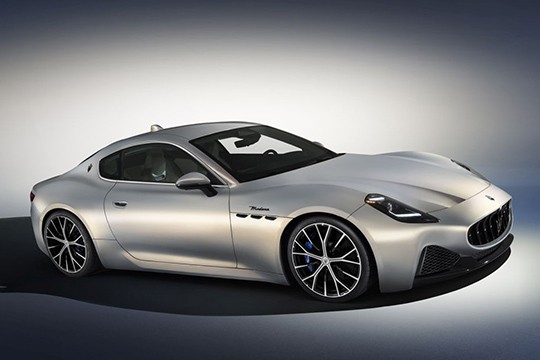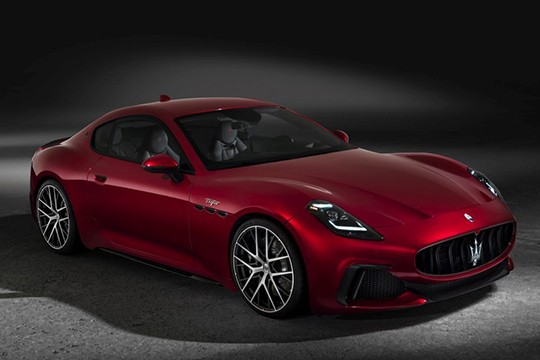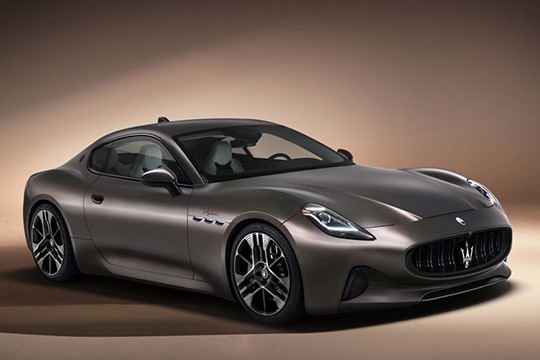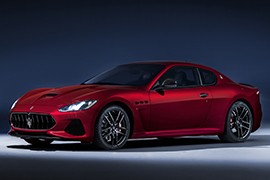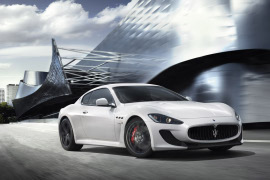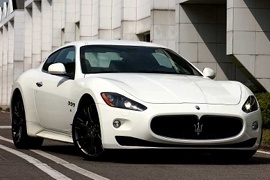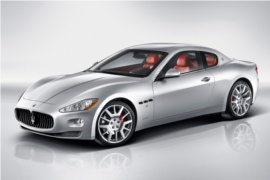MASERATI GranTurismo Models/Series Timeline, Specifications & Photos
First production year: 2007
Engines: Gasoline, Electric
Body style: Coupé (two-door)
Maserati stopped the production of the GranTurismo lineup in 2019, but the Italian brand was already thinking of a replacement, albeit that one came in late 2022.
The Italian automaker didn't rush to keep the former model on the assembly lines, especially during the pandemic years of 2020-2022. By the time it had decided to launch a successor for its beautiful coupe, the automotive industry had already started to shift towards the electric movement. Still, Maserati's name was closely linked to internal combustion engines, so it offered a few of them, such as the Granturismo Modena. Even though the "Modena" name was mostly linked to Maserati's owner, Ferrari, the trident-badge brand was allowed to use it.
On the outside, the car showed a similar profile to the model it replaced. At the front, the LED headlights were no longer swept on the sides but upwards on the front fenders. The car's front fascia featured a fat bumper that sported the main grille surrounded by a chromed trim. Maserati's design team installed a black lip spoiler on the lower side, in the apron, and on the sides, a pair of air intakes that cooled the brakes. Following the carmaker's tradition, the three vents on the front fenders hinted at the six-cylinder under the hood.
Inside, Maserati placed its bets on sportiness, luxury, and technology. Thus, the 2022 GranTurismo boasted a four-seat, leather-wrapped interior. At the front, the high-bolstered bucket seats were comfortable and offered enough side support for high-speed cornering. Finally, the dashboard blended the wood trims and the high-tech displays for the instrument cluster and the infotainment system, respectively, placed atop the center stack.
Under the hood, Maserati installed the twin-turbocharged V6 powerplant developed by Ferrari. In the Modena version, this provided 490 PS (483 hp) sent to the rear wheels via an eight-speed automatic transmission.
Besides the luxurious coupes built for long travels in luxurious cabins, Maserati also made high-performance vehicles created for track days, such as the 2023 GranTurismo Trofeo.
The Italian automaker stopped the production of the GranTurismo I (M145) in 2019 after twelve years of production in various versions. Even though the car didn't look outdated thanks to its beautiful design, it started to show its age due to its platform. So, Maserati prepared a replacement for it that came in late 2022. Along with the version dedicated mostly to long, comfortable travels, it also brought a high-performance version named Trofeo.
Sporting a similar shape as its predecessor, the 2023 Maserati GranTurismo (M189) featured a reworked front fascia with the headlights swept onto the upper side of the fenders. However, unlike the GranTurismo Modena, it showed a black grille without a chromed trim around it. In addition, the lower spoiler and the side intakes were adorned with carbon-fiber elements. Finally, at the back, a carbon-fiber lip spoiler decorated the car's trunk lid. At the same time, under the bumper, the Trofeo showed four exhausts, mounted in pairs on each side, with carbon fiber trims around them.
Inside, the automaker created a cabin fit for four adults with high-bolstered front seats and two individual seats in the back, separated by a center console that split the cabin into two sections. Unlike the Modena version, which boasted wood trims on the dash and door cards, the Trofeo's cabin was covered in leather in most areas. In front of the driver, Maserati installed a TFT display for the instrument panel, while on the center console, it mounted a touchscreen for the infotainment system and a secondary display for HVAC controls.
But the most significant difference was under the hood, where the GranTurismo received the same 2.9-liter twin-turbocharged V6 powerplant as its Modena sibling but tuned for more power.
Maserati stepped up its game and joined the electric-car bandwagon with a high-performance vehicle based on the same platform as the 2023 GranTurismo.
The Italian automaker stopped the production of the GranTurismo's first generation (M145) in 2019. It postponed the launch of the second generation (M189) for three years, until late 2022, after the world pandemic. During these years, it focused on developing a new platform that it could use for IAC and EVs as well. Thus, it made its first full-electric grand touring vehicle, named Folgere (Lightning in Italian), which was faster than its gasoline-powered siblings.
Sporting a similar look to its siblings, the Folgore showed few significant changes. At the front, the car featured the same broad grille adorned with a hexagon-pattern mesh design and vertical slats. But that was mostly masked behind since the motors didn't need such a big cooling area as a gasoline-powered engine. In addition, Maserati installed three vents on the front fenders that looked similar to those placed on the Modena and Trofeo. Still, in this case, they represented the number of motors: three. Finally, at the back, the center-mounted diffuser wasn't flanked by the quad exhausts featured on the rest of the GranTurismo range.
Inside, the luxurious cabin was split into four areas, creating a cocoon-like experience for each occupant. In the front, there was a pair of high-bolstered seats, while in the back, there were two individual seats separated by the car's long center console.
Maserati created a new drivetrain for the Folgore, with one electric motor at the front that powered the front wheels and two at the back for the rear axle. This architecture provided a total output of 762 hp that could propel the car from naught to 62 mph (0-100 kph) in less than three seconds.
The Italian automaker refreshed the GranTurismo for the 2018 model year, and besides the withdrawal of the older 4.2-liter engine, it also added new exterior and interior upgrades.
Maserati’s Styling Center had the difficult job of refreshing the car’s look without spoiling the beautiful lines created by Jason Castriota from the Pininfarina Design Studio. As a result, the carmaker’s artists added subtle changes to the headlights and bodywork. In addition, the car’s interior received a healthy dose of technological input, especially for the infotainment system, which was brought to 2018 standards across the range. But the most significant upgrade was found under the hood, where Maserati ditched the former cross-plane 4.2-liter V8 and installed a fresh 4.7-liter powerplant, initially introduced by the automaker in 2012 on the GranTurismo S version.
While it was difficult to refresh the car’s look since it was already penned well, Maserati’s stylists still could add new lines and enhance the front fascia of the GranTurismo with redesigned headlights. They had the same shape, but their inner side was different, featuring new LED daytime running lights and Bi-Xenon bulbs. The bumper housed the prominent main grille adorned by chromed surroundings and vertical slats, where the Trident badge took center stage. Unlike the previous version, this was more angular, featuring sharper lines than before. Furthermore, a pair of large air scoops flanked the grille, while below the bumper, the 2018 Maserati GranTurismo featured a new lip spoiler.
From its profile, the refreshed GranTurismo featured new decorations for the three vents on the front fenders. In addition, the car boasted exhaust vents behind the wheel arches, similar to those existing on the MC Stradale version. Another subtle change was noticed on the side sills, which featured a new shape and sported a longitudinal crease. Unusually, for this segment of grand touring vehicles, Maserati’s coupe was available in a choice of 16 colors and had 14 light alloy wheels in six designs on the options list. Finally, at the back, Maserati installed a spoiler on the trunk while the entire rear bumper was reshaped. It now had a diffuser underneath it and was flanked by a pair of round exhausts.
Inside, the most significant update was the new infotainment system. Following the market trends, it featured an 8.4-inch touchscreen and supported screen mirroring with Apple CarPlay and Android Auto. From the luxury point of view, the 2018 Maserati GranTurismo was available in six interior trims, ranging from Carbon Fibre to Black Piano and Walnut Briarwood. For an even more pleasant driving experience, Maserati added a new Harman Kardon premium sound system. The car manufacturer also offered seats upholstered in Poltrona Frau leather and Alcantara for an even more exquisite look and feel, and those materials were also applied to the rear bench seat so that two adults could comfortably sit.
Under the hood, the main difference was the new 4.7-liter V8 that was carried over from Ferrari. It was paired with a ZF six-speed automatic gearbox that sent all the oomph to the rear wheels. Unlike the former 4.2-liter powerplant that produced 405 PS (400 hp), the new model came with a punchier 460 PS (454 hp). The hand-built engine was developed and built by Ferrari’s engineers at the Maranello’s factory.
Even though the GranTurismo was a luxurious four-door coupe built to cover long distances in short periods of time, Maserati didn’t want to leave it that way and transformed it into a high-performance, track-focused supercar: the MC Stradale.
With the 2011 Maserati GranTurismo MC Stradale, the Italian automaker proved that it could make any car from its lineup go faster than it was built in the first place. The GranTurismo shared its platform with the four-door Quattroporte model, and despite its excellent weight distribution of 48/52 (front/rear), it wasn’t built for high-speed cornering. With the MC Stradale, it was a completely different story. The automaker improved it in every possible way, from the engine to the suspension and from the exterior look to the interior. As a result, those craving a track-oriented Maserati could get it. Last but not least, the GranTurismo MC Stradale could be driven on public roads, taking its owners in comfort and a luxurious interior.
At the front, the MC Stradale had a different front fascia than the one existing in the regular GranTurismo. It featured a new bumper with a broader air intake on the lower side. Furthermore, Maserati redesigned the hood and added a pair of vents on the rearward part of it to help cool the engine. Unlike the regular GranTurismo, the MC Stradale version featured a black background for the Bi-Xenon headlights.
From its profile, the 2011 Maserati GranTurismo MC Stradale boasted its 20-inch black light alloy wheels and the lowered ground clearance by 25 millimeters (1 inch) compared to its regular sibling. The front fenders featured extracting vents behind the wheel arches to help downforce, which was higher by 25% at the front and 50% at the rear than the rest of the range. Finally, at the back, Maserati placed a larger lip spoiler on the deck, while the rear bumper was redesigned, sporting a diffuser underneath it flanked by a pair of titanium exhausts.
Inside, the most significant change was the removal of the rear seats, which Maserati did to lighten the car. At the same time, the front sports seats were wrapped in Alcantara, and customers could get roll cages and race harnesses as an option. Between the occupants, the automaker placed a center console adorned by carbon fiber trim and buttons for the automated gearbox. Since the car was also built to be driven on public roads, it also featured an AC system and a touchscreen infotainment unit placed on the center console.
But the most essential upgrade was on the technical side. Maserati lightened the vehicle by 110 kg (242 lbs.) compared to the rest of the range. It also included an adaptive suspension and three settings for the automated gearbox that shortened the gear-changing times from 140 in Auto to just 60 milliseconds in Race mode. The gearbox was carried over from the Ferrari F430 and helped the 4.7-liter cross-plane V8 engine to rocket the car from naught to 62 mph (0-100 kph) in under five seconds. To stop the vehicle, the automaker employed a carbon ceramic braking system.
Just one year after the launch of the GranTurismo lineup in 2007, Maserati unveiled a new version of this elegant coupe at the 2008 Geneva Motor Show, and the new version came with more power under its hood.
Creating a legit successor for the Maserati Coupe was challenging, especially since Ferrari took the platform for that model to make the 2008 California. Moreover, it had to develop another vehicle in a very short period of time. The design and engineering teams burned the midnight oil and created the GranTurismo in just nine months. However, that led to some shortcuts, including using a platform shared with the Quattroporte model, which had already been on sale since 2003. Despite all these shortcomings, the automaker launched the GranTurismo at the 2007 Geneva Motor Show. At the same event, albeit one year later, it unveiled the GranTurismo S. With more power under the hood and an upgraded suspension, this version fixed most of the flaws of the initial version.
There were hardly any visual differences between the GranTurismo and the GranTurismo S versions. Maserati wanted to keep the elegant look of the bodywork penned by Jason Castriota at the Pininfarina Design Studio, but it needed some minor changes to make it look different from its sibling. At the front, the broad grille was adorned by black vertical slats, albeit the Trident badge remained chromed, like on the rest of the Maserati range.
From its profile, the GranTurismo S was instantly recognized due to its six-pot red braking calipers and the cross-drilled rotors up front, placed behind the unique multi-spoke alloy wheels. Its three chromed vents from the fenders looked similar, though. Another small change was for the aerodynamically profiled side sills, which featured a front-to-back creased line. Out back, it was difficult to differentiate the two siblings since both sported a quad-exhaust system with round pipes neatly integrated into the lower side of the bumper. As a final design touch, at the back, the automaker added a tiny lip spoiler on the trunk's lid.
Inside, the Alcantara and Poltrona Frau leather upholstery was unique for the GranTurismo S. In addition, the side passenger fronted a badge unique for this version of Maserati's Gran Tourer. Between the high-bolstered front seats, the automaker placed a center console that housed the new automated transmission gear selector and two cup holders. The center stack, on the other hand, had the same infotainment system as the regular GranTurismo. Another unique feat of this version compared with its regular brother was the black background for the instrument panel instead of the silver one.
But the real magic happened under the hood. There, Maserati dropped a new 4.7-liter V8 engine, which was hand-built by Ferrari's technicians in Maranello. It was paired with a new electro-actuated transaxle gearbox, providing faster gear changes, and it was designed by Graziano transmission specialist for the famous Ferrari F430. Besides the standard metallic suspension, Maserati also provided a Skyhook one featuring adaptive dampers.
Maserati launched the GranTurismo as a replacement for the aging Coupe, which was more or less a revamped 1998 3200 GT, and it was developed in a record-time of just nine months from start to finish.
The Italian automaker needed a quick replacement for the 2002 Coupe because customers could feel the underpinnings shared with the 3200 GT from 1998. Unlike those two, the GranTurismo was made on a shortened platform from the fifth generation of the Maserati Quattroporte. Furthermore, it had an engine developed by Ferrari, but instead of a flat-plane crankshaft, it was a cross-plane style. That led to a broader torque curve and a unique sound. For styling, the Italian automaker made a call to its long-time partner Pininfarina Design Studio, which assigned Jason Castriota to pen it. As a result, the car manufacturer could unveil the final product at the 2007 Geneva Motor Show, and customers were delighted about the product, especially because Maserati dropped the former automated gearbox and replaced it with a classic automatic one developed by ZF.
Even though the bio-design era was gone, the Italian automaker insisted on having flowing lines on the bodywork. Those were reflected right off the bat at the front of the GranTurismo. The car impressed the audience with its large grille adorned by vertical slats and sporting the Tridento badge in the middle. It was flanked by swept-back headlights, and underneath them, on the bumper, the automaker added the round fog lights. The coupe car was created as a Gand Tourer, not as a sportscar, so it didn't have an aggressive splitter or oversized air intakes.
From its profile, the low-slung greenhouse started with a raked windshield. Its roofline was arched down behind the B-posts to create more headroom for those seated in the back. On the front fenders, Maserati placed its traditional three vents, while lower, discretely, the Pininfarina badge. Out back, the automaker created a short deck behind the sloped-down rear window. Maserati was criticized for the boomerang-shaped LED taillights of the Coupe and tried to fix that with more extensive, triangular-shaped ones, which resembled those from a European Ford Mondeo from the same era, and that was not very appreciated. Luckily, the rear fascia's look was saved by the lower bumper area, which sported a diffuser and a pair of twin-round exhausts.
Maserati bragged about the GranTurismo as being a genuine four-seat vehicle, and it was. The rear seats were comfortable enough for average-sized passengers, not just for dogs and purses. At the front, the bucket seats provided some level of side bolstered areas, but those were made mostly for comfort. Fronting the driver was a classic-looking dashboard with a double curvature, clearly distinguishing between the driving post and the side passenger area. The center console between them housed the automatic transmission selector and a pair of cup holders.
Under the hood was a 4.2-liter V8 developed by Ferrari for the California. Due to its architecture, the one from the GranTurismo provided less power and torque, but it was still perfectly capable of 285 kph (177 mph). The six-speed automatic transmission was mounted at the front. Despite that, the car's weight distribution was 49%—51 %.
